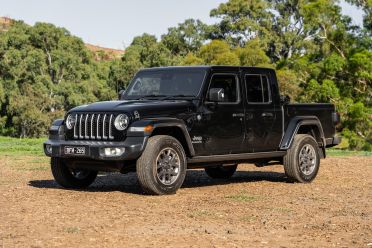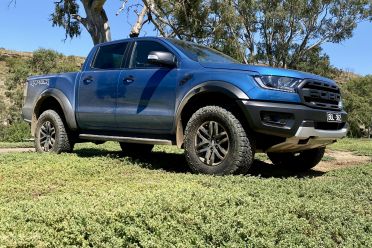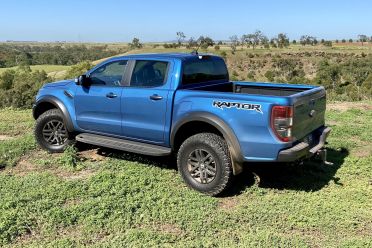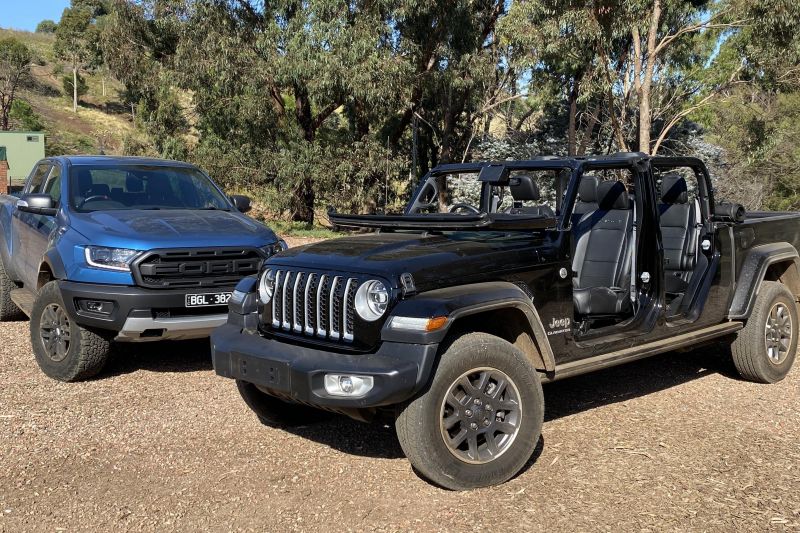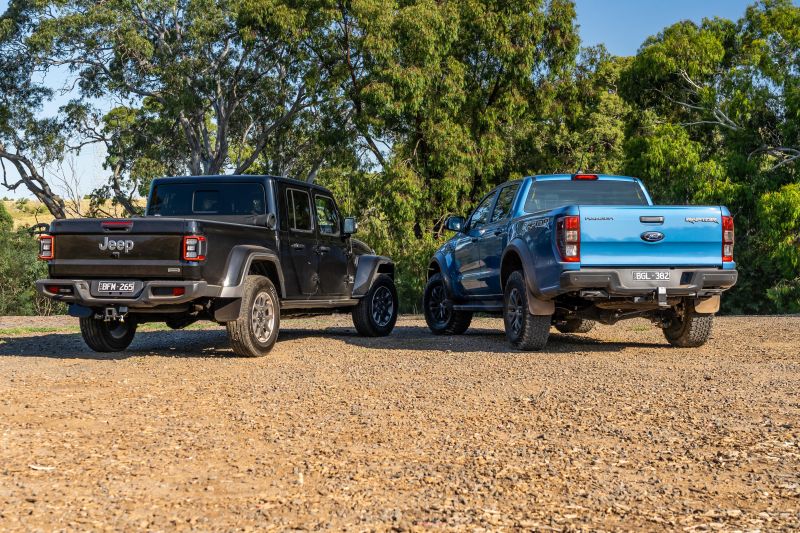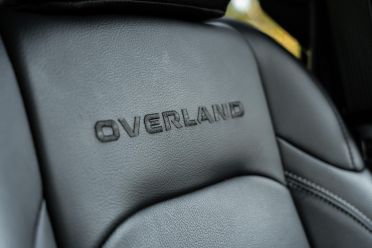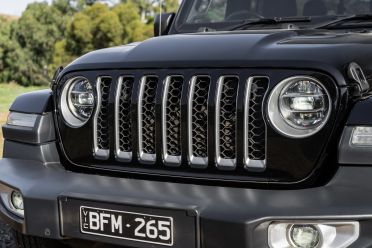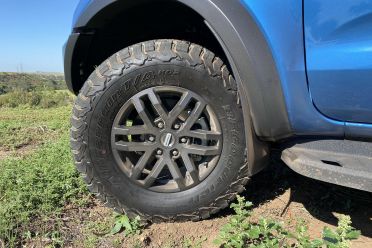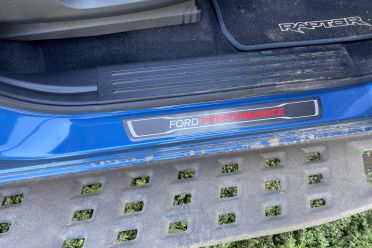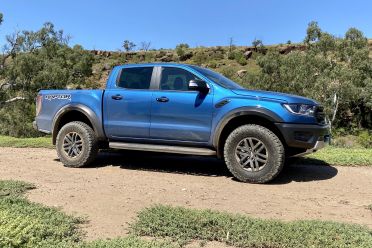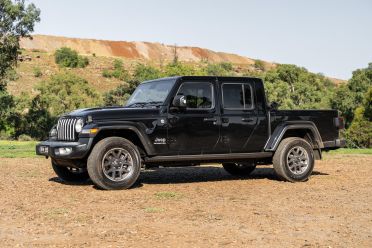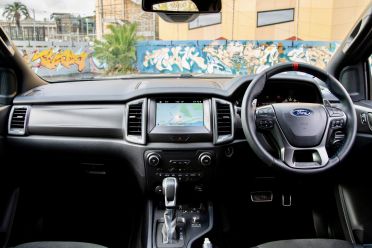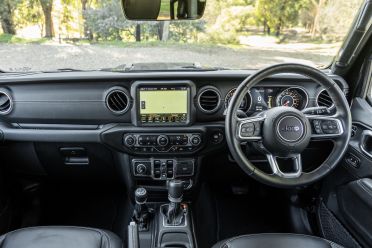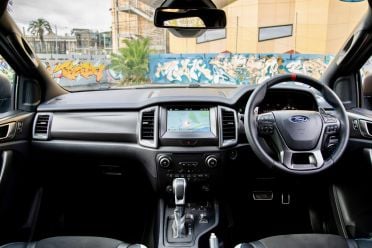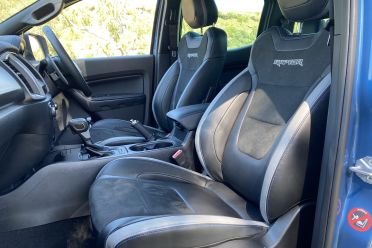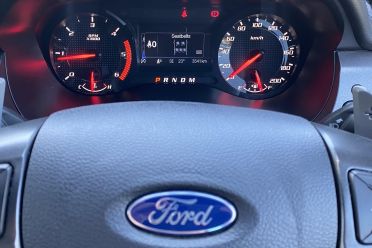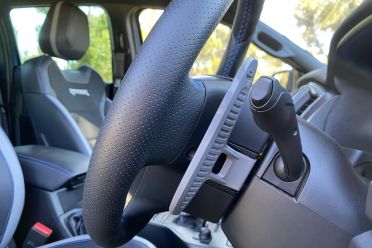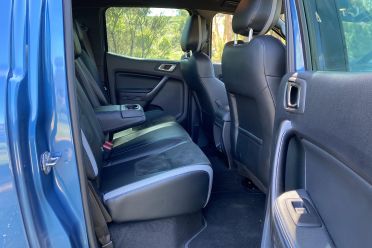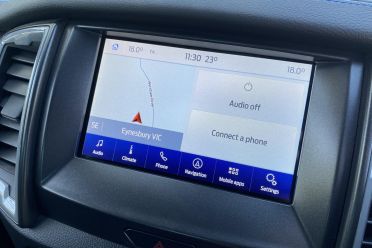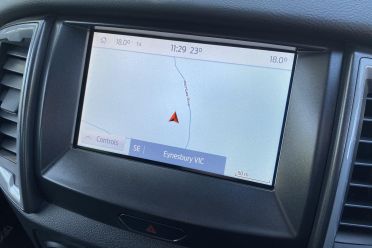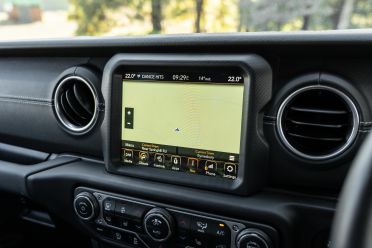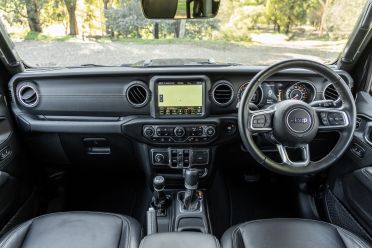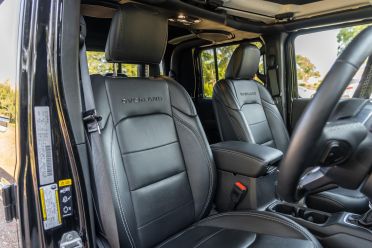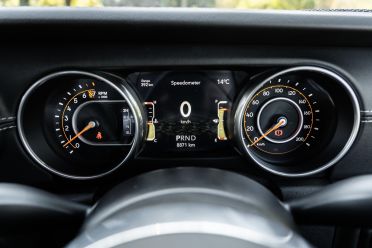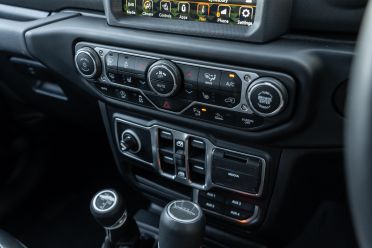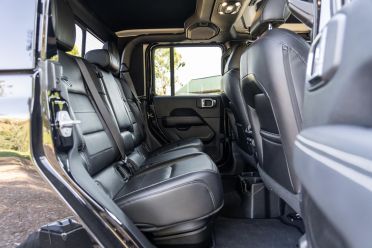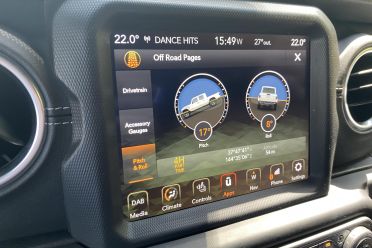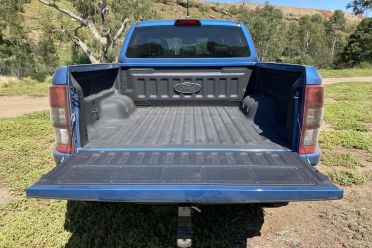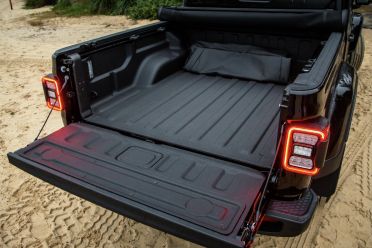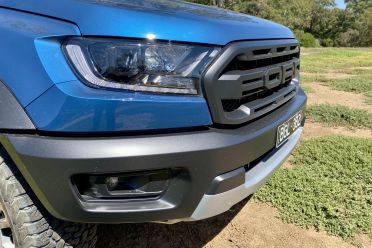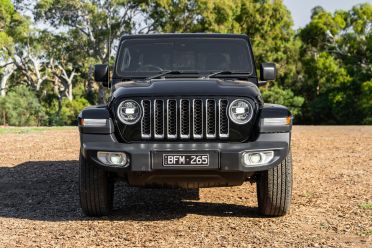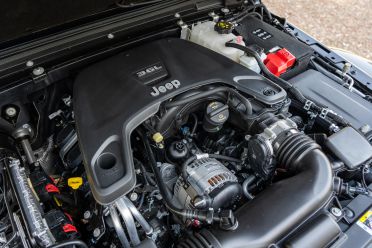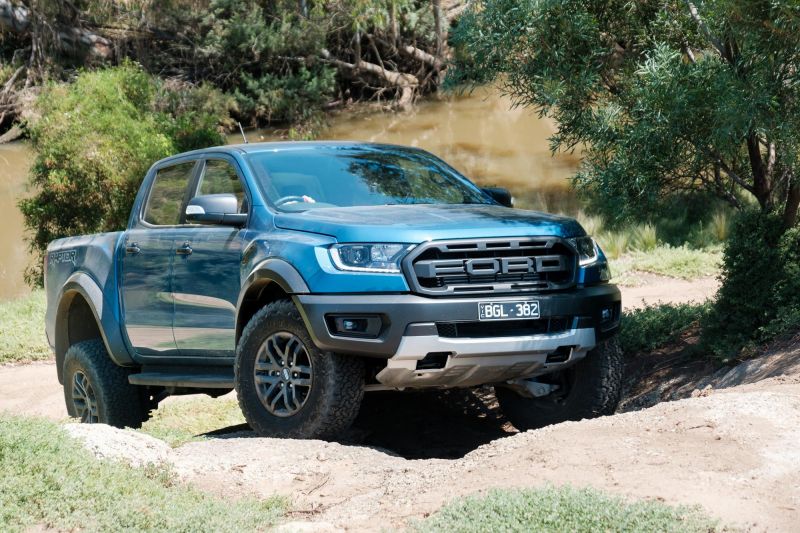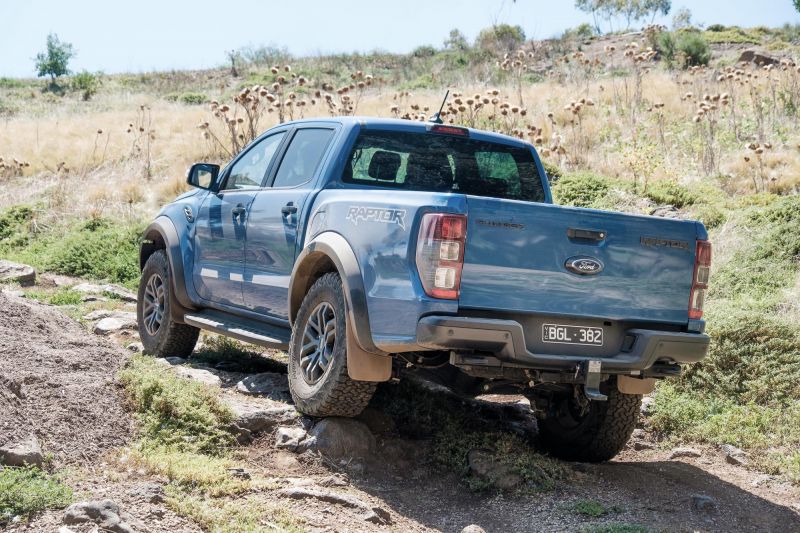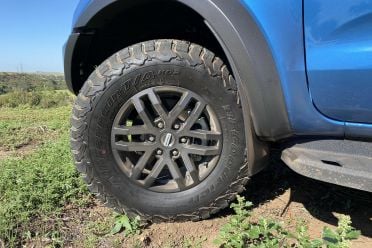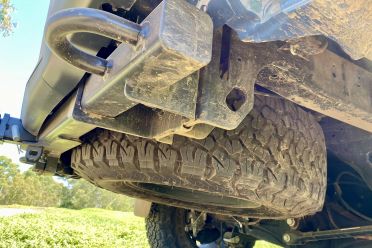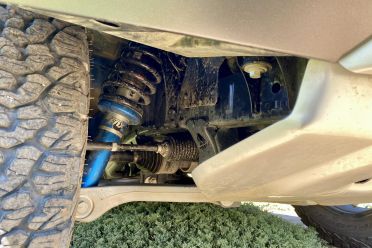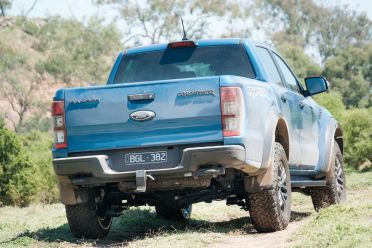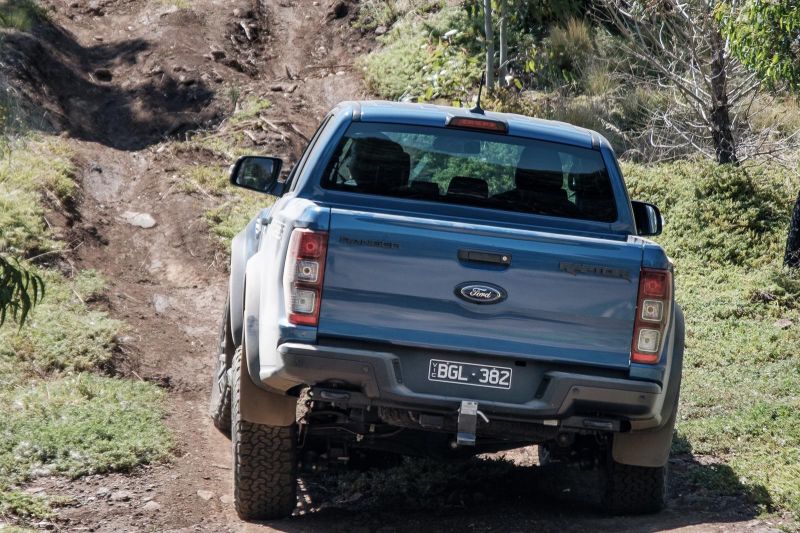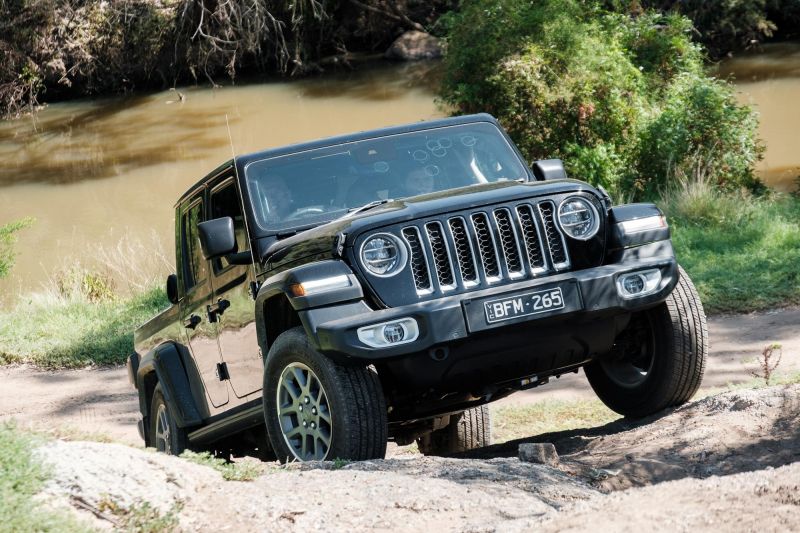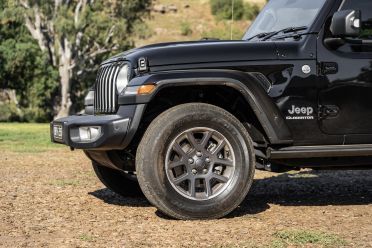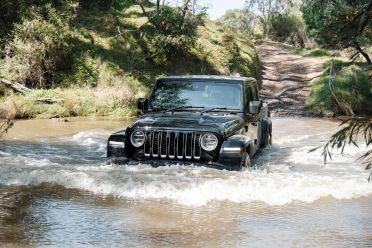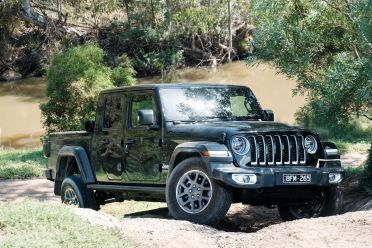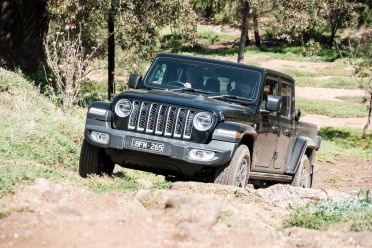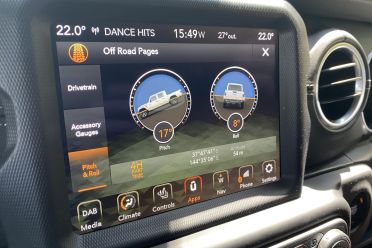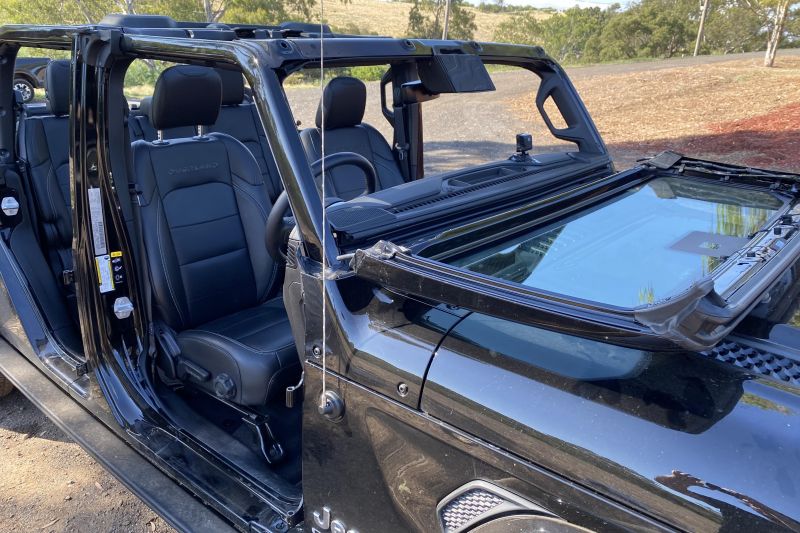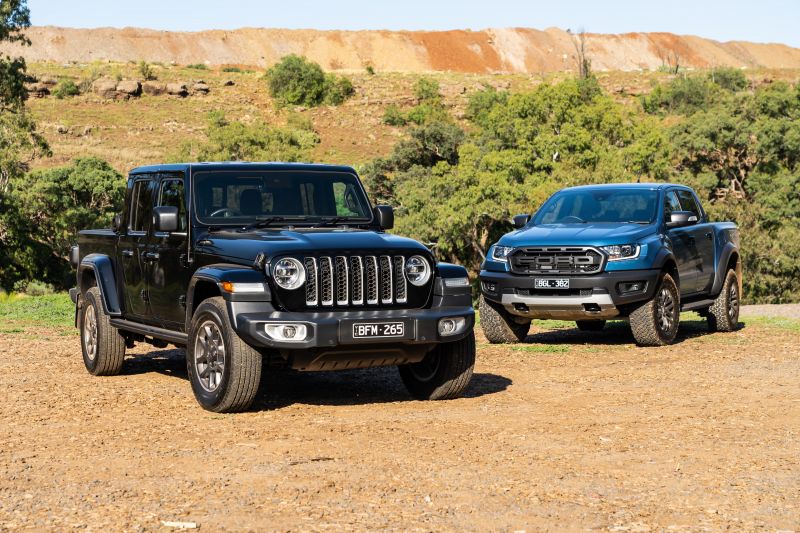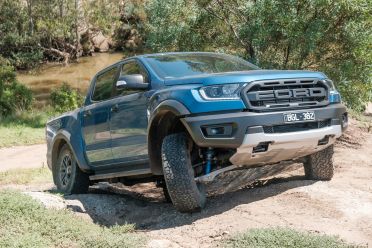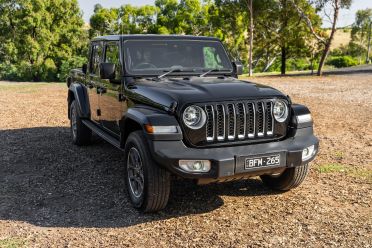Strictly speaking, utes are supposed to be sensible workhorses. But this pair put that stereotype into a cannon and fire it into the sun.
The Ford Ranger Raptor and Jeep Gladiator are two of the most distinctive, shamelessly fun load carriers money can buy — more often seen in the confines of a city, but truly capable of walking over your average 4×4 trail with ease.
In many ways they’re quite a different pair. But at their core they’re trying to do the same things, and speaking to the same kind of buyer.
The Ranger Raptor takes the nation’s regular top-selling 4×4 dual cab and adds stuff like Fox shocks with position-sensitive damping, extra suspension travel, bash plates, stiffened chassis frame rails, fatter all-terrain rubber, and some cosmetic additions.
It’s the closest to an out-of-the-box Baja special that money can buy, in Australia anyway.
In the other corner is the Gladiator, best thought of as being a Wrangler ute. To say there’s nothing quite like it is a statement so obvious that I should’ve spared myself the effort of typing.
What other pickup has removable panels for that open-air experience? We borrowed the mid-level Overland spec grade, but will also talk about the Gladiator Rubicon grade too.
How much?
The Raptor wears a list price of $77,690 before on-road costs (MSRP), which equates to a drive-away price at the time of writing of $82,172 in Victoria.
The cheapest Gladiator Sport S costs $65,450 (MSRP) or $71,162 (drive-away) and the flagship Rubicon will set you back $76,450/$84,158. But here we have the mid-range Gladiator Overland priced at $75,450 (MSRP) or $82,990 drive-away.
| Ford Ranger | Jeep Renegade | Jeep Renegade | |
|---|---|---|---|
| Variant | Raptor | Overland | Rubicon |
| List price | $77,690 | $75,450 | $76,450 |
| Drive-away | $82,172 | $82,990 | $84,158 |
What do you get?
Common equipment includes alloy wheels, LED headlights, proximity key access, heated front seats, satellite navigation, Apple CarPlay and Android Auto, DAB+, and climate control.
Jeep buyers with a further $3800 can buy the Lifestyle Adventure Group package with four programmable AUX switches, a 240A alternator, 700A maintenance battery, lockable under-seat storage, a spray-in bed liner, and a roll-up tonneau cover.
Incidentally, opting for the Gladiator Rubicon over the Overland means losing features including the heated leather seats, heated wheel, and some ‘premium’ interior trims, but gaining 4×4 features such as a 4:1 transfer case, 32″ BF Goodrich AT tyres, a steel rear bumper, Fox shocks, front and rear locking diffs, and a detachable front sway bar.
| Ford Ranger Raptor | Jeep Gladiator Overland | |
|---|---|---|
| Wheels | 17″ alloy | 18″ alloy |
| Tyres | BF Goodrich A/T | Bridgestone Dueler H/T |
| Headlights | Bi-LED | LED |
| Bed liner | Standard | Optional |
| Roof panels | Fixed | Removeable |
| Doors | Fixed | Removeable |
| Windscreen | Fixed | Drops down |
| Side steps | Heavy duty steps | Rock sliders |
| Proximity key | Standard | Standard |
| Seat trim | Leather and Dinamica | Full leather |
| Front seat functions | Powered, heated | Heated |
| Steering wheel heating | No | Standard |
| Touchscreen | 8.0-inch | 8.4-inch |
| Sat nav | Standard | Standard |
| Apple CarPlay | Standard | Standard |
| Android Auto | Standard | Standard |
| DAB+ | Standard | Standard |
| Air conditioning | Climate control | Climate control |
Are they safe?
Common equipment to both includes dual front airbags and dual-front thorax airbags, autonomous emergency braking (AEB), rear parking sensors, trailer-sway control built into the ESC, and reversing cameras.
Only the Ranger has head-protecting side curtain airbags and a lane-keeping aid, but the Gladiator alone has blind-spot monitoring, rear cross-traffic alert, active cruise control, and front sensors.
The regular Ford Ranger has a five-star ANCAP safety rating based on testing out in 2015. Although the Raptor hasn’t been individually tested, it shares most of its safety equipment with the wider Ranger line-up.
The Jeep Gladiator has a poor three-star ANCAP rating from 2019, including a sub-optimal 60 per cent score for adult occupant protection.
What are they like inside?
Ford Ranger:
The Raptor’s cabin isn’t all that different to a regular Ranger’s, but there are some key differences.
Those massive steps jut right out from the body to help you clamber up into the well bolstered bucket seats trimmed in suede and synthetic leather.
The chunky wheel only moves up and down, not telescopically, which is an ergonomic fail. But it’s trimmed in dimpled leather and has a red 12 o’clock marking in the rim. Those oversized wheel-mounted paddle shifters are great.
While a Ranger XLT’s instrument cluster comprises a central analogue gauge flanked by two small screens, the Raptor’s has outboard analogue speedo and tacho displays, and a small trip computer with digital speedo in between.
Ford has livened up the soft dash top with some blue stitchwork, which is also present on the door armrests, gear stick boot, handbrake and wheel. There’s also black headlining.
As with other Rangers, the interior uses hard plastic trims that won’t impress the tactile-minded, but everything is put together well and the trims are easy to keep clean. No dust-magnet glossy trim pieces here.
The centre screen has a bespoke ‘Raptor’ starting sequence but runs Ford’s familiar Sync 3 infotainment with navigation and phone mirroring, plus FordPass app connectivity. The reversing camera is a smidgen grainy but does the job.
Ventilation is controlled by a sequence of buttons which display the task they’re doing on the screen. The knobs and switches are rubbery and damped to my satisfaction.
Storage comprises a cubby below the fascia, a deep centre console, sunglasses bin, door bins with room for a 1.5-litre bottle, and a decent glove compartment.
The back seats have room for two big blokes: I’m 194cm and found acceptable legroom and headroom behind my own driving position.
You get ISOFIX points, cupholders, door bins, map pockets, fold-down grab handles, and both a 12V socket and a 230V powerpoint. But there are no air vents.
The tub has a clever tailgate that’s light enough to lift with a pinkie, six tie-down points, and a 12V socket. It also has a high quality tub liner. It’s a shame the rearmost window doesn’t open up like the Jeep’s.
Jeep:
The Gladiator’s cabin doesn’t feel like any other ute’s – once you’ve clambered in!
The dash is very narrow, meaning you sit closer to the windscreen than you do in the Ranger, or any other pickup. Being able to see the corners of the bonnet helps place what is a huge car in the city, too.
The steering wheel has telescopic adjustment unlike the Ford and the tastefully embossed leather seats felt comfy enough. However, the footwell is a little cramped for work boots, at least for my left foot.
The driver’s instrument cluster comprises two analogue gauges with a digital speedo and trip computer in between.
The use of padded materials on key touch points is welcome, and the fit-and-finish seems excellent, certainly compared to an old Wrangler. All the things you touch, from the chunky leather wheel to the chubby gear selector, feel rugged.
That roughly square centre touchscreen runs FCA’s idiot-proof infotainment system. It starts up fast and there’s minimal menu diving required to move around its various functions, both of which are big ticks.
Although factory navigation is standard, I leaned on Apple CarPlay for mapping. It isn’t wireless, but it worked flawlessly when plugged in.
Below the screen is a bank of rubberised switches for climate control, things like the parking sensors, and the windows. When your doors can be removed, the switches for the windows need to stay in the car.
Storage is fine, from the large cupholders to the deep central bin, but there’s no space under the dashboard and the doors only have flimsy wire pockets.
Rear seat space is actually quite good, although the tiny rear door and protruding metal latch make getting in far harder than it should be – my colleague has the bruise on his hip to prove it.
Legroom is good for adults sitting behind adults, and headroom is similarly generous thanks to the boxy profile. There are air vents and USB chargers back there, along with ISOFIX points on the outboard seats. However, there are no rear airbags, just front-side (in-seat) and dual-front ones.
Flipping up the rear bench reveals a space to store the tools and screws required to take the car apart, along with a locking storage space.
In terms of tub dimensions, the Ford Ranger’s is 1549mm long and 1139mm between the wheels. The Gladiator’s is 1531mm long and 1137mm between the arches.
Two respective payloads aren’t much to write home about: 748kg for the Ranger and a measly 527kg for the Gladiator – expanding to 620kg for the Rubicon.
| Ford Ranger | Jeep Renegade | |
|---|---|---|
| Length | 5398mm | 5591mm |
| Width | 2028mm | 1894mm |
| Height | 1873mm | 1905mm |
| Wheelbase | 3220mm | 3488mm |
| Payload | 748kg | 527kg |
What’s under the bonnet?
Ford:
The Ranger Raptor debuted a new 2.0-litre Bi-Turbo diesel for Ford, with 157kW of power and 500Nm of torque, mated to a 10-speed automatic transmission. That’s 52kW less than the Jeep’s petrol, but 153Nm more.
It uses a part-time four-wheel drive system with low-range and a locking rear diff.
It is rated to use 8.2L/100km on the ADR combined fuel economy cycle but expect around 10L/100km. Braked towing capacity is 2500kg – a tonne less than other Rangers. I managed a 0-100km/h time of just over 10 seconds, six-tenths behind the Gladiator.
Jeep:
The Gladiator houses a naturally-aspirated 3.6-litre petrol V6 engine. It produces 209kW of power and 347Nm of torque, and is mated to an eight-speed automatic transmission.
Unlike the range-topping Rubicon, the Overland uses a four-wheel drive system with low-range, but no locking differentials.
It is rated to use 11.2L/100km on the ADR combined fuel economy cycle but we saw 13.5L/100km. Braked towing capacity is 2721kg. I managed a 0-100km/h time of 9.5 seconds.
There’s no diesel option for right-hand drive markets.
| Ford Ranger | Jeep Renegade | |
|---|---|---|
| Fuel | Diesel | Petrol |
| Displacement | 2.0-litre I4 | 3.6-litre V6 |
| Induction | Bi-turbo sequential | Naturally aspirated |
| Power | 157kW @ 3750rpm | 209kW @ 6400rpm |
| Torque | 500Nm @ 1750rpm | 347Nm @ 4100rpm |
| Transmission | 10-speed auto | 8-speed auto |
| Drive | 4×4 | 4×4 |
| Fuel economy | 8.2L/100km | 11.2L/100km |
| Fuel tank | 80L | 83L |
| Towing capacity | 2500kg | 2721kg |
How do they drive?
Ford:
The 2.0-litre engine may not seem impressive on paper, but its outputs are nothing to sneeze at.
It’s no rocket ship, as my 10-second average zero to 100km/h time attests to, but it’s impressively free of rattling and vibrations. From inside at idle it scarcely sounds like a diesel at all.
The peak torque band is very narrow, but with 10 gear ratios to choose from, the transmission is able to shuffle around to keep the engine in its sweet spot. There’s a hint of indecisiveness there, but the shifts are largely smooth and quick.
Ford has fitted a sound enhancer system that plays a bass-heavy note to accompany throttle presses, which I find a little silly but some people might be into.
The regular Australian-engineered Ranger remains one of the most dynamically well-sorted utes on the market, and the Raptor only enhances this further.
The 285/70 BF Goodrich all-terrain rubber gives plenty of cushy sidewall, and the modded suspension only improves the bump absorption. There ain’t many vehicles that glide over horribly corrugated gravel or pothole-laden Aussie coarse-chip country roads this well.
There’s a hint of shimmying and jitteriness at lower speeds when you’re not carrying a load, but compared to other off-the-shelf utes it rides nicely.
The stability control system is also well sorted. An emergency swerve on gravel elicits a subtle course correction rather than a complete cutting off of torque. With the ESC off, standing circle work is achievable.
Ford electric-driven power steering has copious assistance, to the point that you could steer with a pinky. Not that you should. It has 3.5 turns lock to lock and there’s some numbness off centre that’s suitable for off-roading.
To the off-road side of things. Over the Wildtrak and co, the Ranger Raptor has a strengthened chassis frame, 150mm wider tracks, bash plates, recovery hooks at each end, 33-inch BF Goodrich rubber with reinforced sidewalls, more terrain-management modes, Fox 2.5-inch shocks with stiffer damping at the end of travel, aluminium control arms, and rear coils instead of leafs.
Ground clearance is a whopping 283mm, up 34mm on the Jeep.
The Ranger’s real unique point off the beaten path is its ability to simply dispatch corrugations while driving at speed. It isolates cabin occupants spectacularly well, and feels solid as a rock.
When 4×4-ing at lower speeds, the throttle calibration was pretty good, meaning power on tap without delay. There’s a ton of travel (32 per cent more than other Rangers) and articulation, and if by some miracle you scrape the undercarriage there’s protection.
The Raptor simply walked up the steepest test 4×4 path we could find, especially once we engaged the diff lock. Incidentally, the locking rear diff works in both high- and low-range 4×4.
The main issue was the longitudinal driveshaft vibrations or shunting when taking off from stationary on a steep upslope. The shift from Reverse to Neutral to Drive also caused some body jerking.
Jeep:
The petrol feels gutsier off the line and is much revvier (thus characterful), but it lacks the turbo-diesel Ranger’s mid-range pickup and is clearly less economical. It also bogs the back tyres down a smidgen off the mark.
The eight-speed automatic is a smart partner, keeping the engine between 3500 and 4000rpm where torque is plentiful when the driver leans on the throttle. Really plant your right foot and the transmission will hang onto gears all the way to redline.
The Select-Trac 4×4 system has a full-time mode that automatically switches from 2WD to 4WD when the internal wheel speed and traction control sensors deem it necessary.
Dynamically the Gladiator is quite different to the Ford.
Bump absorption is really good thanks to the chunky 255/70 Bridgestone Dueler highway tyres and plentiful suspension travel. It rounds off sharp hits pretty well.
Noise, vibration and harshness (NVH) isn’t as well suppressed (70dB in the cabin at 100km/h compared to 67dB in the Ford) because of the brick-like aerodynamics and detachable panels.
The body is less rigid than the Ford, meaning you can expect some scuttle shake, though compared to an old Wrangler it feels like a bloody S-Class.
The rear end also skips about more over corrugations, and the steering is weightier than the Ford’s yet less responsive from centre. You’re often making small wheel movements even at straight-ahead.
When off-roading, the seating position offers superior outboard visibility, meaning you can be more accurate on your path. Whip the doors and roof off and the visibility unsurprisingly becomes even better. Just give yourself 20-30 minutes to put everything back together until you’ve mastered the task.
The all-round coils and Dana axles make the Gladiator feel nice and spongy, and it holds the body nicely at a clip over rugged surfaces. But it’s not the high-speed demon the Ford is.
The engine needs more revs to get you moving but is happy to oblige, and the engine braking felt fine. The torque-converter takes a bit to get traction to those tyres, but the degree of articulation means you rarely lose surface contact.
This spec grade clambered up our test hill pretty well, with traction control nudging us upwards. But it’s a bloody long ute with a massive wheelbase, making the breakover angle just 18.4 degrees. At the end of a climb you’ll bottom out from time to time.
I was disappointed to lose the front number plate during a mild water crossing. The self-tapping screws into a plastic bumper aren’t a particularly hardcore solution for plate adhesion.
If you’re planning hardcore 4×4-ing there are two choices: you can buy the Overland and modify it yourself using aftermarket brands you like and trust, or you can buy the Gladiator Rubicon.
This latter variant comes with a Rock-Trac 4×4 system with 4:1 transfer case, locking diffs at each axle to stop freewheeling, 2.0-inch Fox shocks, 32-inch BF Goodrich off-road tyres, a steel rear bumper, a 77:1 crawl ratio, and electronic front sway-bar disconnect to really let you drop into ruts.
You could argue this grade is a better match for the Raptor, and I agree.
| Ford Ranger | Jeep Renegade | |
|---|---|---|
| Rear suspension | Coils | Coils |
| Rear brakes | Ventilated discs | Solid discs |
| 4×4 type | Part-time, low-range | Part-time, low-range |
| Approach angle | 32.5 degrees | 40.7 degrees |
| Departure angle | 24 degrees | 25.1 degrees |
| Breakover angle | 24 degrees | 18.4 degrees |
Cost of ownership
Both Ford and Jeep provide five years of warranty. The Ford plan has no distance limit and Jeep’s is 100,000km.
The Ranger’s service intervals are annual or 15,000km, and the first four visits are each capped at $299. The Gladiator’s intervals are 12 months or 12,000km and the first four visits are each capped at $399.
CarExpert’s Pick
Let’s be honest, if you’re in the market for one of these two, you probably already know what you want.
My heart says Gladiator, because look at the bloody thing. It’s like nothing else on the road, and has unmatched open-air capability and endless scope for modifying.
But in terms of everyday comfort and ergonomics, economy, safety, suburban-friendliness, and high-speed 4×4 ride, the Ranger Raptor has the edge.
Click the images for the full gallery
MORE: Ford Ranger showroom page
MORE: Jeep Gladiator showroom page

